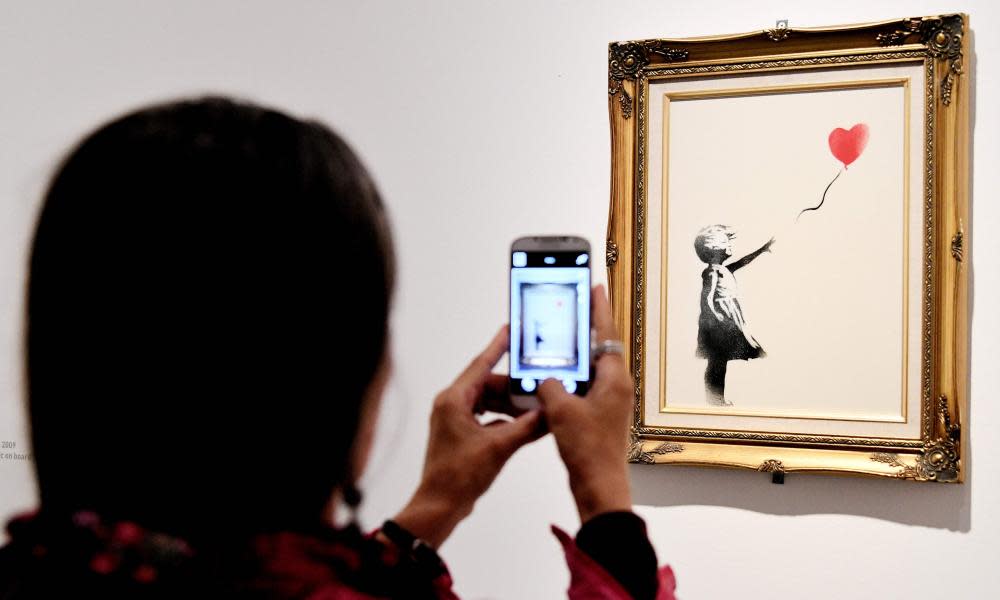Britain’s best-loved artwork is a Banksy. That’s proof of our stupidity | Jonathan Jones

People are stupid. Wait, hear me out. I didn’t say that – although in a time when Donald Trump can get elected US president and a referendum can doom Britain to inglorious isolation, haven’t you occasionally wondered?
I was merely paraphrasing the Victorian art critic John Ruskin, who in his book Modern Painters opines that “the average intellect and feeling of the majority of the public” give them zero competence “to distinguish what is really excellent”. Only a critic, such as himself, with superior sensibility and knowledge can judge what is truly great in art.
I was provoked too when I read this – how can anyone so dismiss popular opinion? Yet the fact that Banksy’s Girl with Balloon has just been voted Britain’s best-loved work of art makes me wonder if Ruskin had a point.
What if the canon really were decided by popularity contests? Raphael, who last won the hearts of the masses in about 1817, would be out on his ear, his portrait of Pope Julius II chucked into the bins behind the National Gallery while Girl with Balloon was stencilled in its place.
Let’s look at Girl with Balloon and see if it deserves its popularity. A girl whose hair and dress are blowing forwards in the wind reaches up to clutch the string of her heart-shaped red balloon. The gust has pulled it out of her hand. It’s away. Aw. Is there any more to say? She is depicted as a simplified black shadow on the wall.
Being generous, I could say this fast street-art stencilling technique suggests the ephemerality not only of the image itself, doomed to be whitewashed by the authorities, but of us all, and our feelings. Yet in reality the effect is to brutally reduce human emotions to the crass and obvious. Instead of portraying a rich human being with mysterious emotions, Banksy gives us a one-dimensional icon whose pathos is instantly readable.
This makes him a brilliant propagandist. He never allows room for ambiguity. Early Soviet film theorists loved to show how montage can change the meaning of an image. A man smiles. Juxtapose it with a workers’ march: he’s a proletarian. Juxtapose it with a pile of gold: he’s an evil capitalist. Banksy has taken propaganda one step further into absolute simplification. His hugely popular anti-theme park Dismaland was bizarre to visit because everything in it was so utterly obvious.
He has invented the artistic equivalent of a tweet. You see it, you get it. Is that really all we want?
Paparazzi snapped a dying Cinderella following her crash. An installation showed how much surveillance there is in modern cities. It was flat and dispiriting to explore, but in media coverage it appeared so much more incisive. Banksy makes art for the media age, particularly the social media age – art you can share in a second because it gives up its entire meaning immediately. He has invented the artistic equivalent of a tweet. You see it, you get it. Is that really all we want?
This is what scares and depresses me about Banksy. The very lack of art in his art is what makes it popular. Real art is elusive, complex, ambiguous and often difficult. Actually, remove that qualifier. It is always difficult. This does not mean it is inaccessible. Constable’s painting The Hay Wain, which was beaten by Banksy in this poll, has an “instant” appeal as a nostalgic image of the English countryside. Look at it a second time and you see it is so much more – a sensitive study of light and atmosphere, a masterpiece of perspective that takes in a vast space, a poem to clouds and water: a profoundly mysterious painting you can study for a lifetime. This is true of all great art and partly true of all worthwhile art whatsoever.
We need to reject bullying populism in art. We need to reject it in politics too, if we want democracy to survive. In art at least it should be easy to state the obvious fact that majority taste is often dead wrong. I learned that from Paul Weller long before I read any Ruskin. “The public gets what the public wants,” declared The Jam in Going Underground – but the artist stands alone and doesn’t care. The whole premise of the most progressive music, from folk to punk, was to reject the banality of pop from within pop itself – to make serious art in a market that was dominated by trash.
Today, we bow down before the trash. At the Globe recently I watched a production of Twelfth Night in which huge slices of Shakespeare’s language were cut or, worse, replaced by banal lines written by the cast or director. Then there were the pop songs, gratuitously added to what was already a cynical farrago. Every time Shakespeare was replaced with some banal dance number, the applause got bigger. I wanted to boo but the audience screamed approval. It was not annoying – it was terrifying: a Nuremberg rally of artistic desecration.
Banksy and that night at the Globe are what happens when we treat art as something that takes no time, effort or passion to understand. We get not the revolutionary anti-art of Dada or punk but a pseudo-subversion that is completely reassuring to the laziest part of us all.
Under its fake radicalism, Banksy’s Girl with Balloon is the kind of sentimental tosh our great grandparents too would have voted as Britain’s best-loved. Its kitsch pathos resembles one of the most popular Victorian images, John Everett Millais’ painting Bubbles, a picture of a child blowing bubbles used as an advert for Pear’s Soap. Today we laugh at it and sneer at them for liking such soppy stuff. Imagine how future generations will mock us for sanctifying Banksy, the Boaty McBoatface of modern art.

 Yahoo News
Yahoo News 
